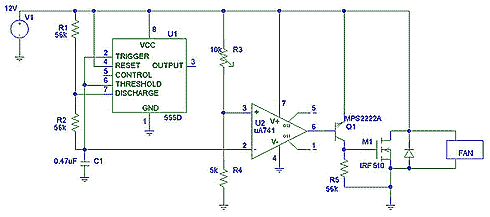Bij ProCooling.com is een klein doch informatief artikel verschenen over de verschillende methodes die bestaan om de geluidsproductie van ventilators te variëren. Naast de bekende methodes zoals de 7V mod, variabele weerstanden en voltage regulator chips wordt het besturen van de fan met behulp van een PWM circuit besproken.
Dit houdt in dat je de ventilator met behulp van een schakeling snel aan en uit zet met een vaste frequentie. De verhouding aan/uit kan je aanpassen waardoor je de snelheid van de fan kan aanpassen. Het voordeel hiervan is dat je de fan op lagere snelheden kan laten draaien dan met mogelijk is met een variabel voltage, en daarnaast is een PWM schakeling efficiënter. Jammer is alleen dat een PWM schakeling bouwen een stuk ingewikkelder is dan de hierboven genoemde alternatieven:
This is my favorite method, mostly because it has such interesting theory behind it. PWM stands for Pulse Width Modulation and it works by turning the fan on and off very rapidly, but at full voltage. If you turn the fan on 100 times a second (100 Hz), and leave the power on for 1/200th of a second, you are providing 50% of the normal power (the power is on half of the time). This is a 50% duty cycle. Leaving the power on all the time is a 100% duty cycle.
[...] Above is the circuit. Basically, there are three main sections: the frequency generator, the PWM signal generator, and the power control. The frequency generator produces a fixed frequency saw-tooth wave. The PWM signal generator uses the fixed frequency saw-tooth wave along with a variable input voltage to produce a variable duty-cycle square wave. The power control uses that square wave to control the power sent to the fan, since the PWM signal generator (the 741 op-amp) cannot supply enough current to power a fan.
 |
